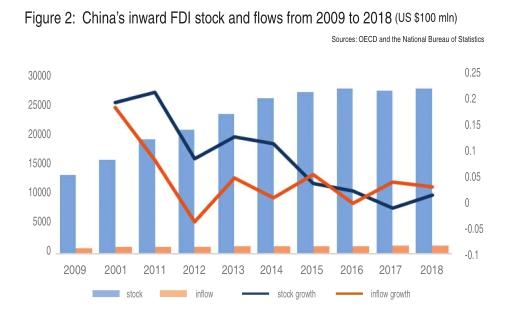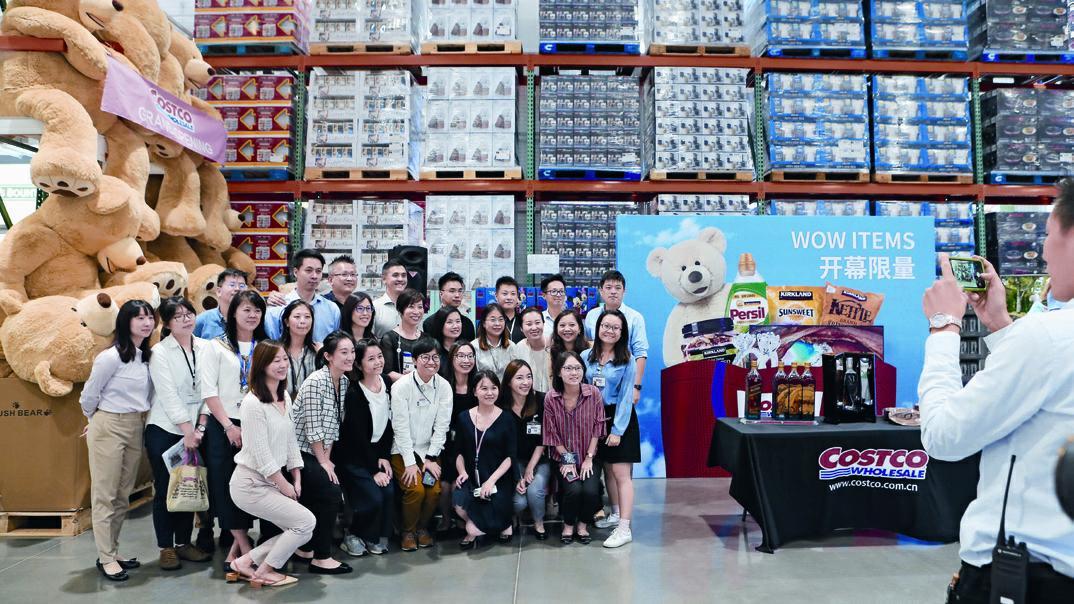Foreign Investors Undeterred by Trade Frictions
By SU QINGYI & WANG RUIYA
THE ongoing China-U.S. trade frictions have raised foreign investors concerns over Chinas macroeconomic prospects, possible restrictions on U.S. companies, and a damper on its business climate. However, numbers speak louder than words. In 2018, foreign direct investment (FDI) in China went up against the global investment outlook, refuting the rhetoric that foreign companies are pulling out of the Chinese market as the U.S. slaps tariffs on Chinese goods.
The World Bank Doing Business 2019 report commended Chinas marked improvement of the business environment. A report of the American Chamber of Commerce in China showed that 90 percent of businesses investing in China pocketed profits or managed to break even in 2018. According to a survey in 2018 by the European Union Chamber of Commerce in China, 62 percent of polled companies regarded China as the current and among the future top three investment destinations.
Bucking the Trend
Amid slowing down FDI worldwide, FDI in China went up and was absorbed by hi-tech industries at a faster pace. According to figures by the National Bureau of Statistics and the Ministry of Commerce, FDI flowing into China in 2018 reached a record high of US $139 billion, registering an increase of four percent. The figure represented more than 10 percent of the global total, making China the second largest FDI destination across the globe and the largest one among developing economies.
From January to June in 2019, Chinas economy grew 6.3 percent year on year and FDI in the country was on the rise. China attracted FDI of RMB 478.33 billion, an increase of 7.2 percent from the previous year. A total of 20,131 foreign-funded enterprises were newly set up. Projects with contract values exceeding US $50 million amounted to 605, a surge of 45.4 percent.
FDI in hi-tech industries rose 44.3 percent and accounted for 28.8 percent of the national total. Figures for the hi-tech manufacturing industry climbed 13.4 percent to RMB 50.28 billion. The hi-tech service industry attracted RMB 87.56 billion, up 71.1 percent year on year. Among that, FDI in information services, research and development services, and services for commercialization of research findings jumped 68.1 percent, 77.7 percent, and 62.7 percent respectively.
As for the FDI sources, investment by South Korea, Singapore, Japan, and Germany rose 63.8 percent, 10.5 percent, 13.1 percent, and 81.3 percent respectively. FDI from the European Union, Association of Southeast Asian Nations, and countries along the Belt and Road route went up 22.5 percent, 7.2 percent, and 8.5 percent respectively.
First of all, China remains committed to opening up and broadening market access. Over the last six years, the country has revised the negative list for foreign investment on five occasions, trimming items on the versions applying nationwide and to all pilot free trade zones (FTZs). In 2019, China further opened its agriculture, mining, manufacturing, and service sectors up to foreign investors and allowed wholly foreignowned enterprises in more areas.
Second, the country has devoted great energy to improving the utilization of FDI. It rolled out incentives to encourage foreign investors to engage in producer service sector and hi-tech industries like advanced manufacturing, electronic information, equipment making, new materials, and modern health product manufacturing. Foreign investors are encouraged to support industrial shifts from coastal areas to central and western China. The second-phase project to make upmarket semi-conductor memory chips backed by Samsung was finished in Xian, west Chinas Shaanxi Province. Pfizer Upjohn is the first multinational pharmaceutical giant which set up its headquarters in China. German chemical company BASF and auto maker BMW, as well as the U.S. Exxon Mobil Corporation, Johnson Controls Inc. and the Hersheys Company built plants and increased investments in China.
Third, China has accelerated the opening up of its financial sector, facilitating foreign investors to grow their businesses in China. Since last year, China has adopted a raft of measures in broadening the market access of foreign investors to its capital market and the financial industry including the sectors of banking and insurance. The UBS Securities Co. Ltd., Nomura Group, and JP Morgan Chase & Co. filed applications with the China Securities Regulatory Commission to become securities traders in China with a controlling stake in a joint venture. International big names in the financial sector like the Daiwa Securities Group and BlackRock Inc. are expected to set up new investment companies in Beijing.
Fourth, China pays high attention to intellectual property rights (IPR) protection and the improvement of the business environment. The country has intensified punishment on IPR infringement and introduced punitive compensation systems to increase the expense for law-breaking acts. The central and local governments also improved the complaint settlement mechanism and services to foreign investors as part of efforts to create an enabling first-class business climate.
Influences of External Environment
The marginal effects of the U.S. sides ambivalence in trade talks and constant tariff slaps on the Chinese economy and FDI in China are diminishing. From March 2018 to August 24, 2019, the bilateral trade spats went on and off. Trump cited the International Emergency Economic Powers Act (IEEPA) on Twitter and ordered U.S. companies to move out of China.
In fact, the ambivalence of the U.S. side has led crossborder investors to realize that its tensions with China will continue to escalate and will not end in a short period of time. They, including those from the U.S., have gradually become less and less insensitive to the backand-forth escalation. New additional tariffs by the U.S. will not pose a real impact on FDI flows to China.
On August 23, 2019, U.S. President Donald Trump tweeted, “Our great American companies are hereby ordered to immediately starting looking for an alternative to China, including bringing your companies home and making your products in the USA.” His idea of invoking the IEEPA of 1977 will lead to nowhere due to lack of authority and opposition from U. S. businesses.
The worlds major media outlets, academics, and the American society unanimously oppose such an order. Multinational companies allocate resources worldwide based on market economy rules to maximize profit. What Trump has said goes against economic laws. According to reports by major media outlets, the move tramples on multilateral trade rules, poses threats to international industrial chains and the global supply chain, drags down international trade, and weighs down the global economy.
Myron Brilliant, executive vice president and head of international affairs at the U.S. Chamber of Commerce, said in a statement that further deteriorating U.S.-China relations were not what they wanted. Media outlets including The New York Times and The Washington Post said Trumps move would only escalate trade frictions and create greater market disquiet.
China would hold up well even if U.S. businesses withdrew. The market is now desensitizing to the extreme pressure on China put by the U.S. As China moves faster in opening-up, U.S.-backed multinational companies will lose a powerful manufacturing base and prospects for profit if they choose to pull out of the market with the most rapidly expanding consumption and the greatest potential of growth. But China will have little to lose, as its market voids will only be filled up by other well-established enterprises.
The global political and economic instabilities, to some extent, spur foreign investors to turn eyes towards China. Apart from trade tensions with China, the U.S. is in discord with its allies as it demanded of them to contribute more protection fees. It put pressure on the European and Japanese manufacturers using national security as an excuse. German auto makers and the British manufacturer Rolls-Royce were excluded from the U.S. market on accusations of posing threats to national security. The Japanese shipbuilding and auto manufacturing industries were investigated by U.S. authorities for their impact on the U.S. employment environment. Of its European allies, it made an exorbitant demand that their annual military expense should be raised to two percent of the GDP. Japan and South Korea were required to contribute as much as US $10 billion as protection fees.
Confronted by this situation, businesses have no choice but to find alternative investment destinations. With a complete industrial chain, a raft of policies for further opening up and improving the business environment, China has become a top choice. It also boasts full-spectrum industries, complete infrastructure, and support systems for industrial development, and a vast amount of skilled labor, enabling global enterprises to commercialize scientific and technological research results in the shortest period at the most optimized expense.
The world-leading British engineering company Rolls-Royce, which focuses on aeronautical engineering and propulsion systems, announced that it would launch a production line for aircraft engines in Tianjin and other Chinese cities in partnership with the Aero Engine Corporation of China. Its investment in China amounted to £10 billion, the largest FDI by a British company over the last 10 years. Airbus SE also said that it would set up a research and development (R&D) center and a production base in China.
In the future, with Chinas improving business climate, IPR protection, and quality of human resources, there will be more foreign-funded enterprises willing to build partnerships in technology, move their headquarters and set up R&D centers in China. Instead of increment, the FDI in China will have quality and efficiency enhanced as it will gradually move from the manufacturing industry to the service sector and from low-end processing to advanced manufacturing. The proportion of FDI from developed economies will go up as more demands will be created in the Chinese market with progressing hi-tech industries, restructured industries, and upgraded consumption.

